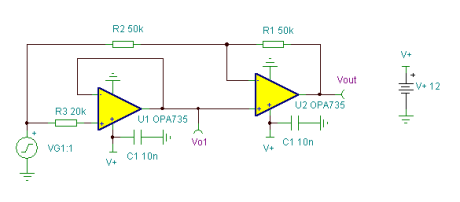Simple Absolute Value Amplifier
The rail- to- rail output characteristics of these CMOS op amps allow them to swing very close to their negative supply rails–ground. By using a non-inverting amplifier U1 to swing only positive (due to its not being capable of swinging below ground), this op amp acts like a perfect rectifier. For positive inputs, the input to the inverting amplifier U2 sees a voltage that is equal to the voltage on its non-inverting input (from follower U1), therefore the net gain of U2 is +1V/V. For negative inputs, the + input to the inverting amplifier U2 sees a voltage that is as close as U1 can swing to its negative supply rail (ground); therefore the net gain of U2 is -1V/V. This output of U1 is amplified by the noise gain of U2 and appears as an offset error on the output of the absolute value amplifier.
This is the primary limitation to accuracy with very small input signals.
This absolute- value amplifier has a gain of +1V/V and has an input range of +/- a few mV to -10V to +10V. (Circuit is created by Thomas Kugelstadt & Neil P. Albaugh, TI – Tucson)
Simple Absolute Value Amplifier circuit:

Online Simulation of the “Simple Absolute Value Amplifier” Circuit
The great feature of the TINA circuit simulator that you can analyze this circuit immediately with TINACloud the online version of TINA. Of course you can also run this circuit in the off-line version of TINA.
Click here to invoke TINACloud and analyze the circuit, or watch our tutorial video!
You can send this link to any TINACloud customers and they can immediatelly load it by a single click and then run using TINACloud.
Michael Koltai
www.tina.com
